Click on images to enlarge.
In addition to the individual efforts by the cylinder manufacturer and sealing supplier, joint activities between the cylinder manufacturer and sealing system supplier can further limit fatigue. Some examples of these joint activities are
• Ensuring proper surface finish, rod hardness and/or surface coating. Proper finish and hardness will allow for an adequate fluid film under the seal and will help limit internal seal stresses.
• Understanding spacing and location of the bearing relative to the seals. Unsuitable location will not allow adequate support for alignment, resulting in higher loading/stress of the sealing components.
• Understanding sealing system component layout and the effect on fluid film thickness. Similar to the end effect of ensuring proper finish, an adequate fluid film under the seal is needed to help limit internal seal stresses.
• Understanding fluid conditions. Changes in viscosity and potential fluid breakdown affect the fluid film thickness that the seals ride on; too thin may result in high internal stresses in the seals.
• Understanding potential hardware dynamics and effectively communicating it. There needs to be joint understanding of the operating conditions in which cyclic high stresses can be imparted onto the seal, such as pressure buildup, ballooning, dithering, or hard start/stop.
• Understanding assembly. As some of the changes from the sealing system supplier concern design, added material or changes in material, assembly needs to be addressed.
AGING – Creep, stress relaxation, and compatibility are all influenced by time and are viewed as aging the components. Temperature and media also are significant factors in how seal designs react to aging. These effects change the way the sealing system performs for leakage control and friction, generally in a negative fashion, and over time will determine its useful life.
Cylinder manufacturers see aging as affecting
• Position control. Seal performance is changing as reflected in friction. As friction is changing, this affects the feedback loop, causing the potential for over-shoot and under-shoot.
• Energy consumption. Increased energy is needed due to the higher frictions caused by changing seal performance.
• Life. Sealing system life and cylinder life are linked. As aging affects sealing systems useful life, it also affects the cylinder’s useful life.
To minimize the effect of aging there are independent actions that can be done by cylinder manufacturers and sealing system suppliers. For cylinder manufacturers these actions are
• Understanding fluid behavior through its life cycle. Changing in viscosity and fluid breakdown will affect the fluid film, which the seal rides on.
• Understanding the operating conditions near the sealing system. This will better define the environment that the sealing system will live in and help determine the appropriate design, layout, and materials for the sealing system.
• Narrowing the tolerance range in which the sealing system must operate. This will limit the amount of variation for which the seal will need to compensate and will narrow down the internal stresses the seal will experience.
• Lowering high end operating temperatures. Higher heat generally has an adverse effect on sealing system performance. This was addressed in the “Moving Faster-Higher Heat” section and is applicable here.
For sealing system suppliers, there are two approaches to investigate:
• Reduce the overall friction of the system, thus lowering the operating temperature. This is done by changing seal contact, by design changes and/or material changes, and adjusting the fluid film under the seal.
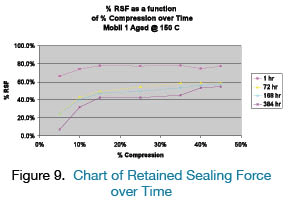 • The other approach is to understand the effects of creep, stress relaxation, and compatibility over time and design with these factors in mind. There is a need to ensure compatibility with the fluid, especially as the fluid breaks down over time and changes due to possible contaminations in the fluid. Sealing system suppliers need to look into using increased creep-resistant materials and materials with higher retained loading over time. Designs need to ensure that the seals are in an optimum state in every operating condition. An example of this is shown in Fig. 9. This figure shows that stress relaxation of the same material at differing initial stress states (compressions) can degrade more rapidly with lower initial stress. This type of effect needs to be considered to enhance sealing system life.
• The other approach is to understand the effects of creep, stress relaxation, and compatibility over time and design with these factors in mind. There is a need to ensure compatibility with the fluid, especially as the fluid breaks down over time and changes due to possible contaminations in the fluid. Sealing system suppliers need to look into using increased creep-resistant materials and materials with higher retained loading over time. Designs need to ensure that the seals are in an optimum state in every operating condition. An example of this is shown in Fig. 9. This figure shows that stress relaxation of the same material at differing initial stress states (compressions) can degrade more rapidly with lower initial stress. This type of effect needs to be considered to enhance sealing system life.
Additional efforts can be done jointly. As mentioned previously, understanding fluid behavior and how it could change are important factors to understand. Joint efforts to reduce heat as mentioned in the first section of this paper (Moving Faster-Higher Heat) are relevant to combat aging:
• Ensuring proper rod hardness and/or surface coating
• Maximizing the load distribution on the bearing
• Changing lubrication pattern underneath the bearings
• Understanding spacing and location of the bearing relative to the seals
• Understanding sealing system component layout and the effect on fluid film thickness to reduce friction and thus heat
• Understanding fluid conditions
• Understanding potential hardware dynamics
Wear – As there is interaction of the sealing system components with the cylinder, wear has an effect on sealing systems lasting longer. The same effects and actions cited in the section “Moving Faster-Wear” to be done by the cylinder manufacturer, the sealing system supplier, and the two parties together can be applied here. There are some additional issues that also must be considered:
• For the sealing system supplier, understanding changes in material characteristics over time due to creep, stress relaxation, or fluid compatibility and its effect on wear need to be considered.
• For the cylinder manufacturer, potential additional movement in the system due to wear of components outside of the sealing system, such as connecting pins, need to be minimized.
• The breakdown of the fluids, which has a significant effect on fluid film under the seal, also affects wear, and this needs to be considered also.
CONTAMINATION – Contamination is caused by internal wear, which generates contaminates, and also by external sources. As cylinders are asked to last longer, contamination has a greater effect on the sealing system by affecting life, friction, and leakage as was cited in that “Lasting Longer-Aging” section. Cylinder manufacturers see similar effects, with changes in
• Position control
• Energy consumption
• Life
• Cost
For contamination, cylinder manufacturers adjust by increasing attention to filtering the fluid and minimizing possible collection points and opportunities for contamination to ingress into the system.
For sealing system suppliers to combat contamination, multiple approaches are taken:
• Trap contaminates by using ingestion ring
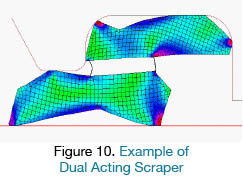 • Use more wear-resistant materials, which can handle the contamination more effectively
• Use more wear-resistant materials, which can handle the contamination more effectively
• Try to eliminate ingress of contaminates by scraping, wiping, or sealing contaminates off more effectively. An example of this is Fig. 10, which shows a polyurethane scraper that has a dual scraping feature. This particular design also does not allow pressure to build up, via a pressure-relieving feature contained within the seal. This feature allows the seal to operate in a near atmospheric condition, regardless of the operating condition, thus avoiding the potential for scraper extrusion or poor wiping performance.
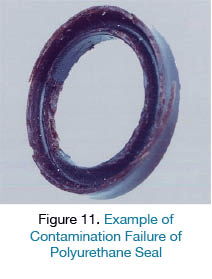 Jointly between the sealing system supplier and cylinder manufacturer, understanding seal system component layout as it affects leakage control and friction relative to packaging spacing and examining returns are some of the areas for improvement. Other efforts should include understanding operating conditions and, in particular, where debris could come from, which will assist in optimizing the sealing system. Fig. 11 shows an application failure in which the ingress of water combined with operating temperature destroyed the seal. This may have been avoided with better understanding initially of possible contaminants that could enter the system.
Jointly between the sealing system supplier and cylinder manufacturer, understanding seal system component layout as it affects leakage control and friction relative to packaging spacing and examining returns are some of the areas for improvement. Other efforts should include understanding operating conditions and, in particular, where debris could come from, which will assist in optimizing the sealing system. Fig. 11 shows an application failure in which the ingress of water combined with operating temperature destroyed the seal. This may have been avoided with better understanding initially of possible contaminants that could enter the system.
stronger
Cylinders are moving toward stronger working conditions. Stronger can mean
• Increased operating pressure
• Higher energy density - same operating pressures but with reduced packaging size either diametrically or axially
Material deformation, hardware dynamics, fluid film integrity, wear, and higher heat are effects associated with sealing system performance in applications with stronger operating conditions.
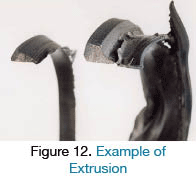 Material Deformation – The compliant materials used in sealing system components have greater deflection with increasing operating pressure, resulting in movement to free space. There are two types of movement:
Material Deformation – The compliant materials used in sealing system components have greater deflection with increasing operating pressure, resulting in movement to free space. There are two types of movement:
• Extrusion. Material moves to a point where it protrudes into the gap of the hardware (Fig. 12).
• Lay-down. Material conforms to the running surface, thus changing its footprint.
Regardless of how the seal material deforms, it has an effect on both the sealing system and the cylinder. For the sealing system, the effect of material deformation is a loss of leakage control, frictional change, and limited life. This, in turn, is seen by the cylinder as affecting
• Positional control. As the friction changes in the sealing system, this affects the feedback loop in the cylinder and thus positional control.
• Load capability. Increased leakage in the sealing system will not allow the cylinder to be able to move the desired load.
• Energy consumption. As the sealing system materials deform, friction can be increased, thus consuming more energy to move the load.
• Cost. Material deformation, if severe, particularly with the bearing components, may allow for metal-to-metal contact; for seals, the deformation may be enough to cause damage to the hardware.
• Life. Sealing system life and cylinder life are linked. Deformation will cause loss of sealing system performance and will eventually lead to limiting the cylinder’s useful life.
Although material deformation of the sealing system components may seen to be the sole responsibility of the sealing system supplier, there are efforts that can be done by cylinder manufacturer alone, sealing system suppler alone and jointly to contend with material deformation.
For the cylinder manufacturer, those actions are
• Reducing the extrusion gap to allow more support for the sealing system components
• Ensuring alignment, so that the extrusion gap is minimized and the seal is not in localized high-stress conditions
• Designing the system to reduce constant pressure conditions, such as putting in a mechanical stop to eliminate a situation of constant high pressure loading
• Reducing Heat. Heat has an adverse effect on material deformation. This will be further explained in the “Stronger-Higher Heat” section.
For the sealing system supplier, there are two primary avenues to pursue:
 • Changing to a more robust sealing system component design by
• Changing to a more robust sealing system component design by
– Changing the design of components to ensure that the design will not deform to a point of severely impacting performance (Fig. 13).
– Adding components, such as backup rings, to limit deformation, which will limit stresses
– Changing materials to those having higher capacity of loading
• Lowering the friction. As heat has an great impact on sealing system component deformation, lowering the friction will lower the temperature around the seal. This will be done by
– Reducing seal contact stress
– Changing the design to allow for a different footprint
– Adjusting fluid film under the seal
– Changing the material
There are three areas where a joint effort by the sealing system supplier and the cylinder manufacturer can assist in limiting sealing system component material deformation due to higher operating pressures:
• Reducing heat
• Ensuring proper surface finish, rod hardness, and/or surface coating. Proper finish for the sealing system is needed to allow for an adequate fluid film, which will reduce friction, heat, and material deformation.
• Changing lubrication pattern underneath the bearings. Adding grooves, cavity, patterns, or splitting the bearing will change the lubrication pattern. This can assist in creating a good fluid film on which the seal rides.
• Understanding sealing system component layout and the effect on fluid film thickness to reduce friction and heat
• Jointly understanding the potential of fluid breakdown and its effects on the fluid film thickness
• Alignment
• Maximizing the load distribution on the bearing. Too high of local loading will add to the system heat and limit life.
• Understanding spacing and location of the bearing relative to the seals. Unsuitable location will not allow adequate support for alignment and will result in higher loading of the sealing components and thus higher heat.
• Effectively understanding and communicating the duty cycle and the assembly process
• Understanding duty cycle. Pressure, temperature, time, and mating hardware all play a role in material deformation. Better understanding of the duty cycle by both parties will assist in addressing pressure, temperature, and time.
• Understanding assembly. As some of the changes from the sealing system supplier concern design or added material or change in material, assembly can become more complicated and thus needs to be mutually addressed and agreed upon.
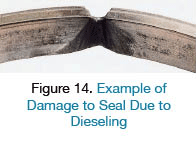 Fluid Film – With stronger operating conditions, the fluid film must operate under more aggressive conditions. This is evident by viscosity changes in the fluid, breakdown, dieseling, or explosive decompression conditions. See Fig. 14 for an example of dieseling. These changes in the fluid film are caused by
Fluid Film – With stronger operating conditions, the fluid film must operate under more aggressive conditions. This is evident by viscosity changes in the fluid, breakdown, dieseling, or explosive decompression conditions. See Fig. 14 for an example of dieseling. These changes in the fluid film are caused by
• Increased shear in the fluid due to valving needed to generate stronger conditions. This also causes increase heat.
• Sealing components. Seals are energized by the fluid. In stronger operating conditions, this causes the seal to have greater stress on the fluid film.
• Air ingression into the system
• Operating conditions, including rapid acceleration or deceleration of the fluid
The fluid film is of great importance for sealing systems as it directly relates to leakage control, friction and life of the sealing system. Without an adequate fluid film, the sealing system will not be able to perform, causing the cylinder to have issues with
• Positions control. As the friction changes in the sealing system, this affects the feedback loop in the cylinder and thus positional control.
• Energy consumption. Changes to the fluid film under the sealing system adversely affect friction and therefore energy consumption.
• Life. Life of the sealing system and cylinder are linked. Loss of fluid film due to breakdown or change in viscosity can eventually lead to limited life. Dieseling and explosive decompression are more catastrophic instances, which also limit life of the sealing system and thus the cylinder.
• Overall cost. Changes in the fluid film can lead to the occurrence of sealing system components riding too heavily on the shaft rather than on the fluid film. This may cause the sealing system components to damage the hardware on which they are running.
Cylinder manufacturers ensure fluid film integrity by
• Ensuring the plumbing and valving has minimal effect of fluid viscosity changes or breakdown
• Minimizing rapid acceleration or deceleration of the fluid near the sealing system to limit the possibility of explosive decompression
• Ensuring that the system design minimizes any air ingression, through tank design, filling method, orientation, or flow patterns to minimize the potential for dieseling
• Ensuring the fluid is stable so that the viscosity changes are limited and that its composition minimizes the chance for dieseling
• Ensuring alignment to minimize high localized loading of the sealing system components
• Minimizing tolerance conditions to limit the amount of variation the seal has to accommodate in the hardware, which will narrow down the internal stress in the sealing system components